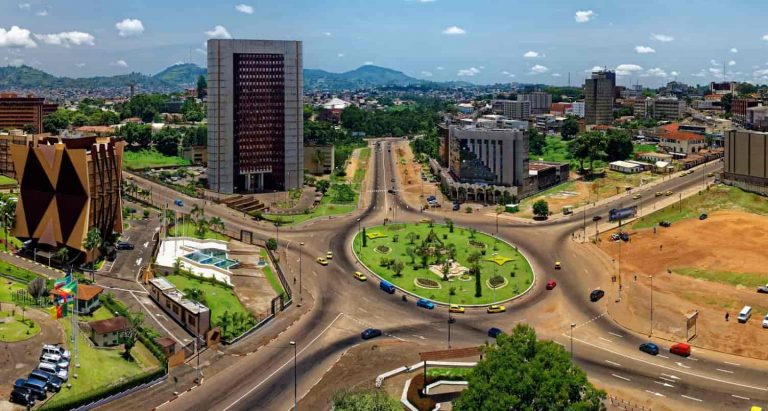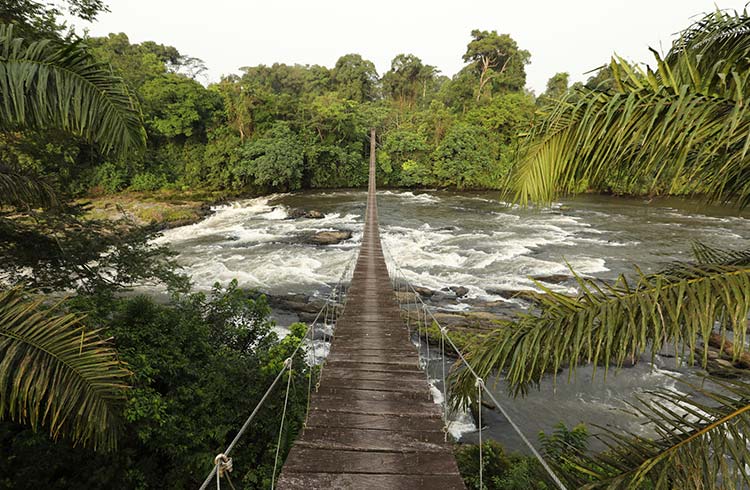Cameroon: A Tapestry of Culture, Nature, and Diversity
 Nestled in the heart of Central Africa lies Cameroon, a country often referred to as "Africa in miniature" due to its incredible diversity of landscapes, cultures, and wildlife. From the verdant rainforests of the south to the arid Sahelian plains in the north, Cameroon offers a rich tapestry of experiences for travelers seeking adventure, cultural immersion, and natural wonders. In this comprehensive article, we delve into the many facets that make Cameroon a unique and captivating destination.
Nestled in the heart of Central Africa lies Cameroon, a country often referred to as "Africa in miniature" due to its incredible diversity of landscapes, cultures, and wildlife. From the verdant rainforests of the south to the arid Sahelian plains in the north, Cameroon offers a rich tapestry of experiences for travelers seeking adventure, cultural immersion, and natural wonders. In this comprehensive article, we delve into the many facets that make Cameroon a unique and captivating destination.
Geography and Climate
Cameroon's geography is as varied as its culture, with terrain ranging from lush coastal plains to towering mountain peaks. The country is divided into four major geographical regions: the Coastal Plain, the Western Highlands, the Adamawa Plateau, and the Northern Plains.
The Coastal Plain, bordering the Gulf of Guinea, is characterized by dense rainforests teeming with biodiversity. This region experiences a hot and humid climate year-round, with abundant rainfall supporting the lush vegetation.
As we move inland, the landscape transitions to the Western Highlands, where the terrain becomes more rugged, marked by volcanic peaks and fertile valleys. Mount Cameroon, the highest peak in West Africa, dominates the landscape here, offering adventurous treks for those seeking panoramic views and challenging climbs.
The Adamawa Plateau, situated between the Western Highlands and the Northern Plains, is a vast expanse of savannah and grasslands. This region is known for its diverse ethnic groups and traditional cultures, offering a glimpse into rural life in Cameroon.
In the far north, the landscape gives way to the arid Northern Plains, where the Sahara Desert encroaches, and temperatures soar during the dry season. Despite the harsh climate, this region is home to resilient communities and unique wildlife adapted to desert conditions.
Cameroon's climate varies from equatorial in the south to semi-arid in the north, with two distinct seasons: the rainy season from April to October and the dry season from November to March. This diverse climate supports a wide range of ecosystems and habitats, making Cameroon a biodiversity hotspot.
Cultural Diversity One of Cameroon's most fascinating aspects is its cultural diversity, with over 250 ethnic groups speaking more than 200 languages and dialects. Each ethnic group has its own traditions, languages, music, and cuisine, contributing to the country's rich cultural tapestry.
One of Cameroon's most fascinating aspects is its cultural diversity, with over 250 ethnic groups speaking more than 200 languages and dialects. Each ethnic group has its own traditions, languages, music, and cuisine, contributing to the country's rich cultural tapestry.
In the western highlands, you'll find the Bamileke people, known for their intricate wooden carvings, colorful masks, and elaborate traditional ceremonies. The Bamoun kingdom, centered in Foumban, is renowned for its royal palace and rich cultural heritage.
In the north, the Fulani nomads roam the savannah with their cattle, practicing a traditional way of life that has remained largely unchanged for centuries. Their colorful attire and ornate jewelry are a testament to their vibrant culture and nomadic lifestyle.
The Tikar people, inhabiting the Adamawa Plateau, are known for their skilled craftsmanship, particularly in pottery and basket weaving. Visitors to this region can witness traditional ceremonies, such as the Nguon festival, celebrating the harvest and fertility.
The coastal regions are home to the Sawa people, whose vibrant music and dance traditions reflect their close connection to the sea. The Duala people, based in the economic capital of Douala, are known for their lively Makossa music and bustling markets.
Despite the diversity of ethnicities and languages, Cameroonians share a strong sense of national identity and pride, uniting under the motto "Unity, Work, Progress." This unity amidst diversity is a hallmark of Cameroonian society and contributes to its peaceful coexistence.
Wildlife and Conservation Cameroon boasts an incredible array of wildlife, thanks to its diverse habitats and protected areas. From majestic elephants and elusive leopards to colorful birds and endemic primates, the country's national parks and reserves offer unparalleled opportunities for wildlife enthusiasts and nature lovers.
Cameroon boasts an incredible array of wildlife, thanks to its diverse habitats and protected areas. From majestic elephants and elusive leopards to colorful birds and endemic primates, the country's national parks and reserves offer unparalleled opportunities for wildlife enthusiasts and nature lovers.
The Waza National Park, located in the far north, is home to a wide variety of Sahelian species, including giraffes, antelopes, and ostriches. Visitors can embark on game drives and guided safaris to observe these magnificent creatures in their natural habitat.
In the south, the Campo Ma'an National Park protects pristine rainforest ecosystems and a myriad of endangered species, such as forest elephants, gorillas, and chimpanzees. Conservation efforts here focus on preserving biodiversity and mitigating threats from poaching and deforestation.
Mount Cameroon, designated as a UNESCO Biosphere Reserve, harbors unique montane forests and endemic plant species adapted to high-altitude conditions. Hiking trails around the mountain provide opportunities to explore this biodiversity hotspot and witness breathtaking landscapes.
The Korup National Park, one of Africa's oldest rainforest reserves, is renowned for its incredible biodiversity, including rare species such as the drill monkey and the Preuss's red colobus. Eco-tourism initiatives in Korup aim to support conservation efforts while providing sustainable livelihoods for local communities.
Cameroon's coastal waters are equally rich in biodiversity, with marine parks such as the Limbe Wildlife Centre playing a crucial role in protecting endangered sea turtles and conserving fragile marine ecosystems. Visitors can participate in educational programs and eco-tours to learn about marine conservation efforts.
Despite these conservation efforts, Cameroon faces numerous challenges, including habitat loss, poaching, and illegal wildlife trade. Collaborative initiatives involving government agencies, NGOs, and local communities are essential for addressing these threats and safeguarding Cameroon's natural heritage for future generations.
Adventure and Recreation For outdoor enthusiasts and adventure seekers, Cameroon offers a wealth of activities and experiences to satisfy every interest and adrenaline level. From trekking through dense jungles to rafting down roaring rivers, the possibilities for adventure are endless.
For outdoor enthusiasts and adventure seekers, Cameroon offers a wealth of activities and experiences to satisfy every interest and adrenaline level. From trekking through dense jungles to rafting down roaring rivers, the possibilities for adventure are endless.
Hiking enthusiasts flock to Mount Cameroon, where guided expeditions lead climbers through diverse ecosystems, from lush rainforests to barren volcanic slopes. Summiting the peak offers not only a sense of accomplishment but also stunning views of the surrounding landscapes.
The Lobe Waterfalls, located near the coastal town of Kribi, provide a refreshing retreat for travelers seeking relaxation and natural beauty. Visitors can swim in the crystal-clear pools beneath the cascading waters or take a boat ride to explore nearby mangrove forests.
For water sports enthusiasts, the Sanaga River offers exhilarating whitewater rafting opportunities, with rapids ranging from gentle to challenging. Experienced guides ensure a safe and thrilling experience as adventurers navigate the river's twists and turns.
Nature lovers can explore the vast network of national parks and reserves, embarking on guided wildlife safaris, birdwatching excursions, and nocturnal forest walks. Whether tracking gorillas in the dense rainforest or spotting rare bird species in the wetlands, the opportunities for wildlife encounters are endless.
Cultural immersion experiences abound in Cameroon, with opportunities to visit traditional villages, attend vibrant festivals, and participate in cultural workshops. Whether learning traditional dance moves or mastering the art of pottery, travelers can gain insight into the rich cultural heritage of Cameroon's diverse ethnic groups.
Cuisine and Culinary Delights No visit to Cameroon would be complete without sampling its delicious and diverse cuisine, influenced by the country's cultural mosaic and abundant natural resources. From hearty stews and spicy sauces to tropical fruits and freshly caught seafood, Cameroonian cuisine is a culinary delight for food lovers.
No visit to Cameroon would be complete without sampling its delicious and diverse cuisine, influenced by the country's cultural mosaic and abundant natural resources. From hearty stews and spicy sauces to tropical fruits and freshly caught seafood, Cameroonian cuisine is a culinary delight for food lovers.
One of Cameroon's signature dishes is Ndole, a flavorful stew made with bitterleaf greens, groundnuts, and meat or fish. This hearty dish is often served with plantains or fufu, a staple starch made from cassava or maize.
Another popular dish is Poulet DG, a savory chicken and vegetable stir-fry cooked in a rich tomato sauce. This colorful and aromatic dish is often served with fried plantains and rice, creating a satisfying and flavorful meal.
For seafood lovers, Cameroon's coastal regions offer a bounty of fresh fish and shellfish, prepared in a variety of delicious ways. Grilled fish, served with spicy pepper sauce and grilled plantains, is a favorite among locals and visitors alike.
Cameroon's street food scene is vibrant and diverse, with roadside vendors selling an array of tasty snacks and treats. Suya, skewered and grilled meat seasoned with spices and served with sliced onions and chili peppers, is a popular street food enjoyed throughout the country.
To satisfy a sweet tooth, visitors can indulge in Cameroonian desserts such as puff-puff, deep-fried dough balls dusted with powdered sugar, or banana cake, a moist and flavorful cake made with ripe bananas and spices.
Conclusion Cameroon is a country of contrasts and diversity, where lush rainforests meet arid savannahs, and traditional cultures thrive amidst modernization. From its breathtaking natural landscapes to its rich cultural heritage, Cameroon offers a tapestry of experiences for travelers seeking adventure, exploration, and immersion.
Cameroon is a country of contrasts and diversity, where lush rainforests meet arid savannahs, and traditional cultures thrive amidst modernization. From its breathtaking natural landscapes to its rich cultural heritage, Cameroon offers a tapestry of experiences for travelers seeking adventure, exploration, and immersion.
Whether trekking through dense jungles, exploring vibrant markets, or sampling delicious cuisine, visitors to Cameroon are sure to be captivated by its beauty, warmth, and hospitality. With its incredible biodiversity, cultural richness, and spirit of resilience, Cameroon truly stands out as a gem of Central Africa, inviting travelers to discover its wonders and treasures firsthand.





































